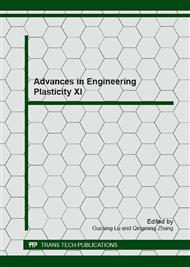[1]
H. Watarai, Trends of Research and Development for Magnesium Alloys – Reducing the Weight of Structural Materials in Motor Vehicles, Science and Technology Trends, Quarterly Review, No. 18 (2006).
Google Scholar
[2]
I. Ostrovdky, Y. Henn, Present state and Future of Magnesium Application in Aerospace Industry, International Conference "New Challenges in Aeronautics" ASTEC'07, August 19-22 (2007), Moscow.
Google Scholar
[3]
Ishikawa, K., Watanabe, H, Mukai, T., High temperature compressive properties over a wide range of strain rates in an AZ31 magnesium alloy. Journal of Materials Science, 2005. Vol. 40, pp.1577-82.
DOI: 10.1007/s10853-005-0656-1
Google Scholar
[4]
Cheng-wan T., S.-n.X., Wang Lu, Zhi-yong C., Fu-chi W., Hong-nian C., Hong-lei Ma., Deformation behaviour of AZ31 magnesium alloy at different strain rates and temperatures. Transactions of Nonferrous Metals Society of China, 2007. Vol. 17, pp.347-352.
Google Scholar
[5]
Yang Yong-biao, F.-c., W., Cheng-wen, T., Yuan-yuan, Wu, Hong-nian, C, Plastic deformation mechanism of AZ31 magnesium alloy under high strain rate compression. Nonferrous Metal Society China, 2008. Vol. 18, pp.1043-46.
DOI: 10.1016/s1003-6326(08)60178-8
Google Scholar
[6]
Suyuan, Y., The microstructure features and the deformation mechanism of a fine grained magnesium alloy under dynamic loading. Reviews on Advanced Materials Science, 2010. Vol. 25(2), pp.122-127.
Google Scholar
[7]
Ulacia, I., Yi, S., Perez-prado, M. T., Dudamell, N. V., Galvez, F., Letzig, D., Hurtado, I., Texture Evolution of AZ31 magnesium alloy sheet at high strain rates. Proceedings, 4th International Conference on High Speed Forming, 2010, pp.189-197.
DOI: 10.4028/www.scientific.net/msf.706-709.1255
Google Scholar
[8]
H. Kolsky, 1949. An investigation of the mechanical properties at very high strain rates of loading. Proc. Phys. Soc. B., Vol. 62, pp.676-701.
DOI: 10.1088/0370-1301/62/11/302
Google Scholar
[9]
ASTM, ASTM standards, in B557M-07, Standard Test Methods of Tension Testing Wrought and Cast Aluminium- and Magnesium-Alloy Products [Metric]
DOI: 10.1520/b0557m-07e01
Google Scholar
[10]
Tucker, M.T., Horstemeyer, M. F., Gullett, P. M., Haithem El Kadiri and Whittington, W. R., Anisotropic effects on the strain rate dependence of a wrought magnesium alloy. Scripta Materialia, 2009. Vol. 60, pp.182-85.
DOI: 10.1016/j.scriptamat.2008.10.011
Google Scholar


